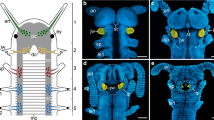Summary
The influence of theramus palatinus (VII.) and the postion of the vomer on the vomerine bar, which develops during metamorphosis, was studied by various amputation procedures. Cutting off the nerve cord does not prevent the development of the vomerine bar, as the nerve soon regenerates, whereas cutting off and displacement as well as the removal of portions of theramus palatinus do prevent development. Removal of portions of the nerve cord during metamorphosis produces only parts of the vomerine bar. Obviously an intact ramus palatinus is necessary for the outgrowth of the novel osseous vomerine bar. The course of this outgrowth is independent of the position of the larval vomer.
Zusammenfassung
BeiSalamandra salamandra wurde der Einfluß desRamus palatinus (VII.) und der Lage des Vomer auf die sich während der Metamorphose bildende Vomerspange untersucht. Eine Durchtrennung des Nerven stört das Wachstum der Spange nicht, da der Nerr rasch regeneriert. Nach Durchtrennung und Verlagerung desRamus palatinus bildet sich jedoch keine Vomerspange, ebenso nicht nach Exstirpation eines Teiles des Nerven. Nach Entnahme von Nervenstücken nach Beginn der Metamorphose entwikkeln sich Teilspangen. Das Vorhandensein eines intaktenRamus palatinus ist offenbar Voraussetzung für das Auswachsen der neuen knöchernen Vomerspange. Die Richtung des Spangenwachstums ist nicht von einer bestimmten Lage des Larvenvomer abhängig.
Similar content being viewed by others
Literatur
Clemen, G.: Aufbau und Veränderungen der Gaumenzahnleisten beim larvalen und metamorphosierendenSalamandra salamandra (L.) (Salamandridae: Amphibia). Zoomorphologie90, 135–150 (1978a)
Clemen, G.: Beziehungen zwischen Gaumenknochen und ihren Zahnleisten beiSalamandra salamandra (L.) während der metamorphose. Wilhelm Roux' Arch. Entwicklungsmech. Org.185, 19–36 (1978b)
Clemen, G.: Untersuchungen zur Bildung der Vomerspange beiSalamandra salamandra (L.). Wilhelm Roux' Arch. Entwicklungsmech. Org.185, 305–321 (1979)
Clemen, G., Greven, H.: Morphologische Untersuchungen an der Mundhöhle von Urodelen I. Die Gaumenzähne vonSalamandra salamandra (L.) (Salamandridae: Amphibia). Forma Functio7, 249–280 (1974)
Clemen, G., Greven, H.: Morphologische Untersuchungen an der Mundhöhle von Urodelen III. Die Munddachbezahnung vonAmbystoma mexicanum Cope (Ambystomatidae: Amphibia). Zool. Jb. Anat.98, 95–136 (1977)
Dresden, M.H.: Denervation effect on newt limb regeneration: DNA, RNA, and protein synthesis. Dev. Biol.19, 311–320 (1969)
Francis, E.: The anatomy of the salamander. Oxford: Clarendon Press 1934
Geigy, R.: Die Metamorphose als Folge gewebsspezifischer Determination. Rev. Suisse Zool.48, 483–494 (1941)
Hartwig, H.: Metamorphose-Reaktionen auf einen lokalisierten Hormonreiz. Biol. Zentralbl.60, 473–478 (1940)
Romeis, B.: Mikroskopische Technik. München-Wien: Oldenbourg 1968
Singer, M.: The influence of the nerve in regeneration of the amphibian extremity. Q. Rev. Biol.27, 169–200 (1952)
Singer, M.: Nervous mechanisms in the regeneration of body parts in vertebrates. In: Developing cell systems and their control (D. Rudnick, ed.), New York: Ronald Press 1960
Stadtmüller, F.: Studien am Urodelenschädel. I. Zur Entwicklungsgeschichte des Kopfskeletts derSalamandra maculosa. Z. Anat. Entwicklungsgesch.75, 149–225 (1924)
Thornton, C.S.: Amphibian limb regeneration and its relation to nerves. Am. Zool.10, 113–118 (1970)
Wagner, G.: Die Bedeutung der Neuralleiste für die Kopfgestaltung der Amphibienlarven. Rev. Suisse Zool.56, 519–620 (1949)
Wintrebert, P.: Le mode d'édification du yomer définitif au cours de la métamorphose chez les Salamandridae. C. R. Acad. Sci. Ser. D:175, 239–241 (1922)
Woerdemann, M.W.: Development of the teeth inTriton andAmblystoma. In: Experimental Embryology in the Netherlands, 1940–1945. Amsterdam-London, New York: Elsevier 1946
Author information
Authors and Affiliations
Additional information
Für die Unterstützung bei der Anfertigung dieser Arbeit danke ich herzlich Herrn Professor Dr. H. Hartwig, Zoologisches Institut der Universität Köln
Rights and permissions
About this article
Cite this article
Clemen, G. Die Bedeutung desRamus palatinus für die Vomerspangenbildung beiSalamandra salamandra (L.). Wilhelm Roux' Archiv 187, 219–230 (1979). https://doi.org/10.1007/BF00848618
Received:
Accepted:
Issue Date:
DOI: https://doi.org/10.1007/BF00848618




